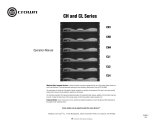Page is loading ...

Crown International, Inc.
P.O. Box 1000
Elkhart, IN 46515-1000
TEL: 219-294-8200
FAX: 219-294-8FAX
www.crownaudio.com
CH4
08/00 131514-1
For more details refer to the applicable Reference Manual or
Contact Crown Audio Technical Support. The provided data
should not be construed as specications.
Crown is a registered trademark of Crown International, Inc.
Printed in U.S.A.
© 2000 Crown International, Inc.
AC Power Draw and Thermal Dissipation
C O N T R A C T O R S E R I E S
This document provides detailed information about the amount of power
and current drawn from the AC mains by the CH4 amplier and the
amount of heat produced under various conditions. The calculations pre-
sented here are intended to provide a realistic and reliable depiction of
the amplier. The following assumptions or approximations were made:
• The amplier’s available channels are loaded and full power is being
delivered.
• The amplier efciency at standard 1-kHz power is estimated to be
77%.
• Quiescent power draw is approximately 140 watts.
• When running at full speed, typical power draw for the internal fan is
approximately 12 watts.
• The estimated duty cycles take into account the typical crest factor for
each type of source material.
• Duty cycle of pink noise is 50%.
• Duty cycle of highly compressed rock ‘n’ roll midrange is 40%.
• Duty cycle of rock ‘n’ roll is 30%.
• Duty cycle of background music is 20%.
• Duty cycle of continuous speech is 10%.
• Duty cycle of infrequent, short duration paging is 1%.
Here are the equations used to calculate the data presented in Figure 1:
The following equation converts power draw in watts to current draw in
amperes:
The value used for Power Factor is 0.98. The Power Factor variable is
needed to compensate for the difference in phase between the AC mains
voltage and current. The following equation is used to calculate thermal
dissipation:
The value used for inefciency is 0.23 (1.00–0.77). The factor 3.415
converts watts to btu/hr. Thermal dissipation in btu is divided by the
constant 3.968 to get kcal. If you plan to measure output power under
real-world conditions, the following equation may also be helpful:
Figure 1 Power Draw, Current Draw and Thermal Dissipation at Various Duty Cycles
/







